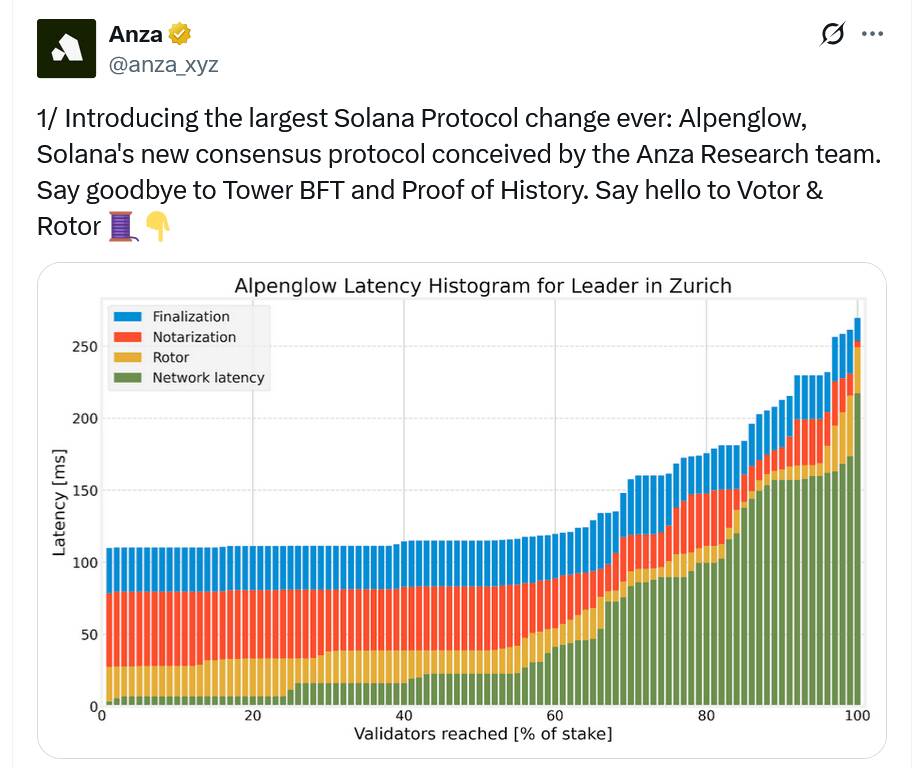Anza, a blockchain infrastructure firm that emerged from Solana Labs, has introduced a groundbreaking proposal for Solana’s core protocol, named Alpenglow. Marketed as a revolutionary proof-of-stake consensus mechanism, Alpenglow is poised to significantly enhance Solana’s functionality, aiming to position it as a formidable competitor to conventional internet infrastructure. The key architects behind this initiative, Quentin Kniep, Kobi Sliwinski, and Roger Wattenhofer, are optimistic that the implementation of Alpenglow will mark a pivotal moment in the evolution of Solana, noting it as perhaps the most substantial innovation since the blockchain’s inception.
Alpenglow introduces two main components: Votor, which is responsible for voting transactions and block finalization, and Rotor, a new data dissemination protocol that seeks to replace Solana’s existing proof-of-history timestamping system. This innovative approach aims to slash the time required for all network nodes to agree on the current state of the blockchain. Anza’s team has set ambitious targets, asserting that Alpenglow could achieve actual finality in approximately 150 milliseconds, thereby enabling the Solana network to compete with traditional web technologies in responsiveness.
According to Anza’s research, this level of efficiency will not only demonstrate the speed of Solana but also broaden the applications of blockchain technology to include more real-time performance demands, which were previously challenging to meet. Votor aims to finalize blocks rapidly—within one round if at least 80% of the stake participates, and in two rounds with a minimum of 60% participation, ensuring enhanced operational efficiency even in tough network conditions.
However, while the prospects of Alpenglow are exciting, the white paper explicitly acknowledges that this new consensus won’t entirely resolve the network outages that Solana has experienced in the past. Currently, Solana’s infrastructure relies on a single production-ready client, Agave, making it vulnerable to security issues that could disrupt the entire network. Fortunately, the introduction of a new independent validator client, Firedancer, is scheduled for release on Solana’s mainnet later this year, which is expected to offer much-needed diversity and robustness to its operations.
Anza Proposes New Alpenglow Consensus Protocol for Solana
Key points regarding Anza’s proposal for a new proof-of-stake consensus protocol named Alpenglow, and its potential impact on the Solana blockchain and its users:
- Overview of Alpenglow
Alpenglow is a new consensus protocol that represents a significant change to Solana’s core protocol.
- Components of Alpenglow
- Votor: Processes voting transactions and block finalization logic, replacing the existing TowerBFT.
- Rotor: A data dissemination protocol aimed at replacing the proof-of-history timestamping system.
- Latency Improvements
Alpenglow aims to achieve actual finality in approximately 150 milliseconds, enhancing Solana’s competitiveness with current internet infrastructure.
- Potential Applications
A lower latency can enable blockchain technology to cater to new categories of applications requiring real-time performance, impacting various industries.
- Voting Modes in Votor
Votor can finalize blocks in a single round with 80% participation or in two rounds with 60%, resulting in increased efficiency and responsiveness.
- Operational Resilience
The model incorporates concurrent voting modes, allowing for effective operation under challenging network conditions.
- Continued Vulnerabilities
Despite the advancements, Alpenglow will not fully mitigate the network outages Solana has previously experienced.
- Future Developments
The introduction of Firedancer, an independent validator client, is expected to enhance client diversification and improve network security.
“Alpenglow will shatter both these latency bounds.” – Anza Researchers
Anza’s Alpenglow: A Game Changer or More of the Same for Solana?
In the fast-paced world of blockchain technology, Anza’s introduction of Alpenglow is making waves. Positioned as a “huge leap” for Solana, this proof-of-stake consensus mechanism aims to revolutionize how the platform operates, particularly in terms of speed and efficiency. However, while ambitious, there are notable considerations regarding its competitive edge and potential drawbacks when compared to similar developments in the blockchain space.
Comparative Advantages: Alpenglow promises unparalleled performance, boasting median latencies as low as 150 milliseconds. This puts Solana on a competitive pedestal alongside traditional Web2 infrastructure, potentially drawing developers and projects that require real-time performance. By integrating Votor and Rotor, Anza seeks not just to enhance transaction speeds but to offer a new way to manage data dissemination, making Solana more appealing to high-demand applications. This is particularly relevant in sectors like gaming and finance, where latency can significantly affect user experience and engagement.
Competitive Disadvantages: Despite these promising features, Alpenglow doesn’t fully address the recurring issue of network outages that have stained Solana’s reputation. While the proposed client diversification with the launch of Firedancer is a step forward, reliance on a single production-ready client, Agave, raises concerns about systemic vulnerabilities. Compared to blockchain platforms with multiple, robust client options, Solana may still appear risky to some developers. Moreover, if the Alpenglow transition falters, it could further exacerbate existing trust issues within the community.
Target Audience: Alpenglow could be a boon for developers looking for ultra-responsive blockchain solutions. Enterprises that rely heavily on swift transactions, such as DeFi projects or real-time data companies, might find Solana’s revamped infrastructure particularly enticing. However, projects that prioritize stability and robust client diversity might think twice before committing to Solana, especially if they’ve experienced the previous outages or are already entrenched in ecosystems with proven reliability.
As Anza positions Alpenglow as a transformative force within the space, its success may hinge on not just the technology itself but how effectively it can address these vulnerabilities—an endeavor that will undoubtedly shape Solana’s future in an increasingly competitive blockchain landscape.

















